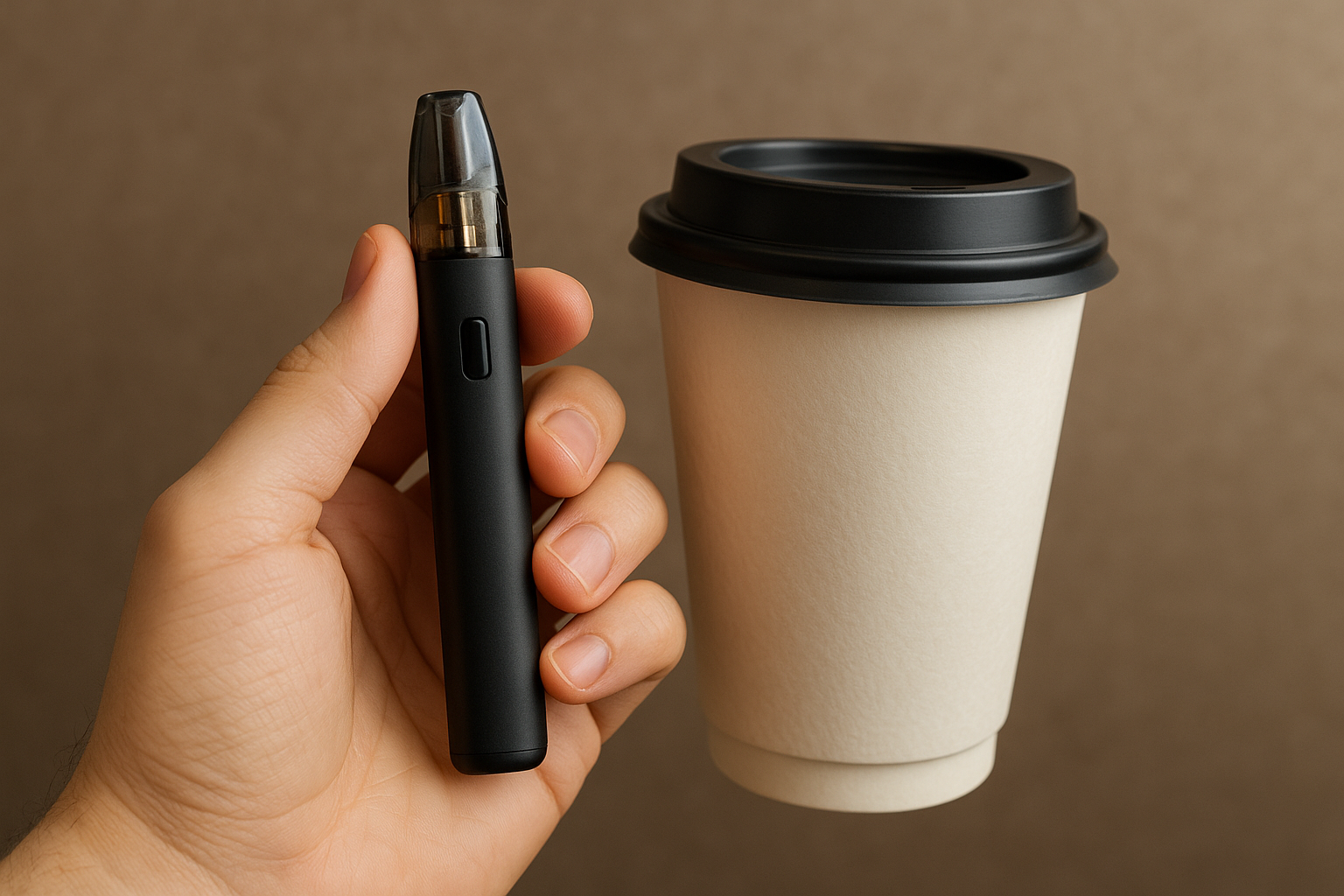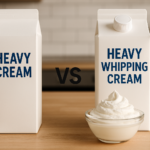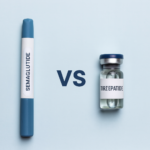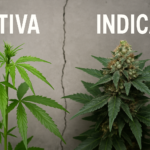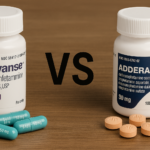Energy comes in many forms — from a morning cup of coffee to a can of energy drink. But a new trend is reshaping the way people get their caffeine fix: caffeine vapes. These small, sleek devices promise an instant energy boost without the sugar or calories of traditional beverages. They’re marketed as fast, convenient, and even “healthier.”
But are caffeine vapes really a smarter choice — or just another risky fad wrapped in clever marketing? Let’s dive into what caffeine vapes are, how they work, what science says about them, and whether they’re safe for long-term use.
What Exactly Is a Caffeine Vape?
A caffeine vape is a handheld electronic device that delivers inhalable caffeine vapor into your lungs. Instead of drinking coffee or energy drinks, users inhale caffeine through a vaporized mist. The product often looks like a disposable e-cigarette but contains no nicotine or tobacco.
How It Works?
When you puff on a caffeine vape, the liquid inside (known as e-liquid or vape juice) heats up and turns into a fine vapor. This vapor contains caffeine and sometimes additional ingredients like vitamins (B12, taurine) or natural flavorings.
Once inhaled, caffeine is absorbed through the lung’s alveoli directly into the bloodstream — giving a faster, more immediate effect compared to drinking it.
Why Are Caffeine Vapes Becoming Popular?
The caffeine vape market has grown rapidly, especially among young adults, students, and professionals who want a quick energy kick. Several factors explain the hype:
- Instant energy: The effects are felt in seconds rather than minutes.
- No sugar or calories: Unlike energy drinks, caffeine vapes don’t contain added sugars or artificial sweeteners.
- Portable and discreet: Easy to carry and use anywhere, even in places where coffee isn’t convenient.
- Nicotine-free option: Some users see it as a “safer vape” compared to traditional vaping.
However, just because a product seems healthier doesn’t necessarily mean it is. The absence of nicotine doesn’t eliminate other potential risks.
How Caffeine Affects the Body?
To understand caffeine vaping, it’s important to look at how caffeine works inside the body.
Caffeine is a natural stimulant that blocks adenosine receptors in the brain — chemicals that make you feel tired. By doing so, it promotes alertness, focus, and temporarily boosts energy.
After consumption (or inhalation), caffeine can:
- Increase heart rate and blood pressure
- Enhance alertness and concentration
- Improve physical performance and endurance
- Delay fatigue
Normally, when you drink coffee, caffeine enters your bloodstream gradually through digestion. But with vaping, the stimulant bypasses the digestive system and goes directly into your bloodstream through the lungs — delivering a much faster and sometimes stronger hit.
Potential Benefits of Caffeine Vapes
Proponents of caffeine vapes highlight several appealing benefits:
1. Fast-Acting Energy
Inhaled caffeine reaches the brain within seconds, offering almost immediate stimulation — perfect for people who need a quick pick-me-up before a workout or a late-night study session.
2. No Calories, No Sugar
For calorie-conscious individuals or those avoiding energy drinks, caffeine vapes seem like a “clean” alternative. They don’t contain the sugar, carbohydrates, or artificial additives found in most caffeinated beverages.
3. Portable Convenience
No brewing, no waiting, no spills — caffeine vapes fit easily in a pocket or bag. Many users like the ease of getting a caffeine boost anywhere, from the gym to the office.
4. Nicotine-Free Option
Caffeine vapes provide the hand-to-mouth satisfaction of vaping without nicotine, making them attractive to ex-smokers or those avoiding addictive substances.
But Are Caffeine Vapes Really Safe?
Here’s where things get complicated. While caffeine itself is well-studied and generally safe in moderate doses, inhaling it through vapor is relatively new — and long-term research is limited.
1. Lack of Regulation
Unlike coffee or energy drinks, caffeine vapes are not tightly regulated by the U.S. Food and Drug Administration (FDA). This means product quality, purity, and caffeine concentration can vary widely from brand to brand. Some may contain unknown chemicals or inaccurate caffeine levels, increasing health risks.
2. Uncertain Absorption and Overdose Risks
When you drink coffee, your stomach limits how fast caffeine enters your system. But vaping caffeine bypasses that natural control.
This can lead to rapid caffeine spikes in the blood — potentially causing symptoms like:
- Jitters or anxiety
- Rapid heartbeat
- Dizziness
- Nausea
- Insomnia
In severe cases, too much caffeine can trigger heart palpitations or panic attacks, especially in sensitive individuals.
3. Possible Lung Irritation
Even though caffeine vapes are nicotine-free, the vaporization process still involves heating substances that can irritate or inflame lung tissue.
Some vape liquids include propylene glycol or glycerin, which, when heated repeatedly, may produce toxic compounds like formaldehyde or acrolein. While the risk level is unclear, inhaling any chemical vapor isn’t entirely harmless.
4. False Sense of Safety
Many people assume caffeine vapes are “healthy” just because they don’t contain nicotine. This can lead to overuse — with users taking multiple puffs throughout the day, unaware of how much caffeine they’re actually consuming.
Comparing Caffeine Vaping vs. Traditional Caffeine Sources
| Aspect | Caffeine Vape | Coffee / Energy Drinks |
| Absorption Speed | Almost instant (via lungs) | Gradual (via digestion) |
| Control Over Intake | Hard to measure dosage | Easy to track (mg per serving) |
| Calories/Sugar | 0 calories | Often high (in energy drinks) |
| Health Research | Very limited | Extensive studies available |
| Additives & Flavorings | Variable, sometimes synthetic | Usually natural or listed |
| Long-term Effects | Unknown | Well-understood and generally safe |
In short — caffeine vaping offers convenience and speed but sacrifices scientific certainty and safety assurance.
What Experts and Health Organizations Say?
Medical and health experts remain cautious.
The American Lung Association warns that any kind of vaping — even without nicotine — may harm lung health. Meanwhile, researchers from several universities have expressed concern about unregulated caffeine concentrations in vape products.
Dr. Dana Hunnes, a senior dietitian at UCLA Medical Center, notes:
“Just because a product delivers caffeine doesn’t mean it’s safe. We simply don’t know what inhaling these compounds does over time.”
The consensus among experts is that caffeine vapes may not be immediately dangerous, but their long-term effects are still unknown. Until more studies are done, health professionals recommend sticking to proven caffeine sources like coffee or tea.
Who Should Avoid Caffeine Vapes?
Certain individuals are more vulnerable to caffeine’s side effects — especially when inhaled:
- Pregnant women: High caffeine levels may increase the risk of complications.
- People with heart conditions: Caffeine spikes can trigger palpitations or arrhythmias.
- Individuals with anxiety or sleep disorders: Inhaled caffeine may worsen symptoms.
- Teens and young adults: Developing bodies are more sensitive to stimulants, and vapes may normalize vaping habits in general.
Legal and Market Status
Caffeine vapes are currently not banned in most countries, but regulatory attention is increasing. The FDA has issued warnings to some manufacturers for making unverified health claims or selling mislabeled products.
In some regions (like parts of Europe and Australia), caffeine vapes fall into a gray legal area — not strictly illegal but not officially approved either. This lack of oversight is one of the main reasons health authorities remain skeptical.
Healthier Alternatives to Caffeine Vaping
If you’re looking for an energy boost without the uncertainty of vaping, consider these safer, well-researched options:
- Black coffee or espresso: Pure caffeine, zero sugar, and easy to measure.
- Green tea or matcha: Offers caffeine plus calming L-theanine for balanced energy.
- Energy shots or tablets: Controlled doses, usually between 100–200 mg caffeine.
- Hydration + short walks: Sometimes fatigue is more about dehydration or inactivity than caffeine deficiency.
These methods may not be as trendy as vaping, but they’re scientifically supported and much safer.
The Future of Caffeine Vaping: Innovation or Illusion?
There’s no denying that caffeine vapes are an innovative idea. They cater to a modern, fast-paced lifestyle where people crave instant energy without extra calories.
However, innovation doesn’t always equal improvement. Without proper regulation, research, and safety testing, caffeine vaping may be more of a marketing experiment than a genuine health advancement.
Manufacturers will likely continue improving formulas and delivery methods, but until health agencies publish reliable long-term data, caution is the best approach.
Final Thoughts: Should You Try Caffeine Vaping?
Caffeine vapes may sound appealing — fast energy, no sugar, no nicotine. But beneath the convenience lies a major uncertainty: safety. The long-term effects of inhaling caffeine are not well understood, and the lack of FDA regulation means product quality can’t always be trusted.
If you’re seeking an energy boost, tried-and-true options like coffee, tea, or pre-workout supplements remain far safer and more predictable.
In short:
Caffeine vapes might be an exciting innovation, but for now, they’re more of a risky fad than a proven healthy alternative.
My name is Mustafa, and I have been blogging for over 5 years. I am passionate about sharing complete, accurate, and helpful information with my readers. Along with managing content on The Matcha Read, I also contribute blog posts to premium websites. My goal is to provide valuable insights in a clear and easy-to-understand way, so every reader walks away with useful knowledge.
